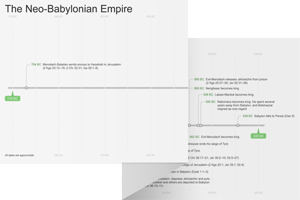47:1–7 This oracle of judgment against the Philistines is probably connected to Nebuchadnezzar’s destruction of Ashkelon in 604 bc, though the editorial heading in v. 1 connects it with an Egyptian campaign against Gaza. However, the region of Philistia was the battleground for part of the confrontation between Babylon and Egypt in 601 bc. |
 Oracles against the Nations Table
Oracles against the Nations Table
47:1 the Philistines Inhabitants of the coastal plain west of Judah. See note on Ezek 25:15–17.
Pharaoh attacked Gaza Herodotus records that, after repelling Nebuchadnezzar’s invasion in 601 bc, Neco continued north and captured the Philistine city of Gaza. On Gaza, see note on Jer 25:20; on Neco, see note on 46:2.
47:2 Look, waters are rising from the north The image of rising waters is used for Egypt in 46:7–8, but the warning of danger from the north suggests Babylonian attack.
47:4 Tyre and from Sidon Phoenician cities, presumably mentioned because they are allies of the Philistines. On the Phoenicians, see note on Ezek 26:1–28:26.
the coastland of Caphtor Usually identified with Crete, the homeland of the Philistines according to Amos 9:7.
47:5 Baldness Probably alluding to mourning rituals accompanying national distress. Compare Amos 8:10.
Ashkelon A Philistine seaport that was destroyed by Nebuchadnezzar in 604 bc. See note on Jer 47:1–7.
Ashkelon was an ancient Canaanite city-state on the Mediterranean coast. Joshua 13:3 lists it as one of the five cities of the Philistines, and it was captured by Judah during the conquest (Judg 1:18). Ashkelon also is mentioned in the story of Samson (Judg 14:19). Most likely, the Canaanite city was settled by the Philistines after the Sea Peoples failed to conquer Egypt around 1190 bc. Ashkelon was a strategic port—a logical place for Egypt to station enemies-turned-mercenaries who had invaded by sea. Ashkelon did not yield to Babylonian rule after the Battle of Carchemish, so Nebuchadnezzar destroyed the city in 604 bc. It was rebuilt into a thriving port in the Persian period and continued to be an important regional city until 1270 ad. |
will you cut yourself with a blade Refers to mourning rituals. See note on Jer 41:5.

|
About Faithlife Study BibleFaithlife Study Bible (FSB) is your guide to the ancient world of the Old and New Testaments, with study notes and articles that draw from a wide range of academic research. FSB helps you learn how to think about interpretation methods and issues so that you can gain a deeper understanding of the text. |
| Copyright |
Copyright 2012 Logos Bible Software. |
| Support Info | fsb |
 Loading…
Loading…




 who entered Syria-Palestine by land and sea through the Aegean basin and Asia Minor around 1200
who entered Syria-Palestine by land and sea through the Aegean basin and Asia Minor around 1200  Ashkelon
Ashkelon